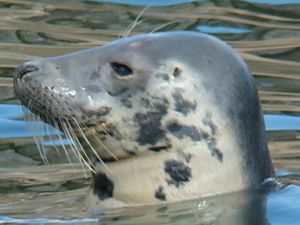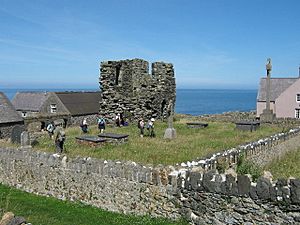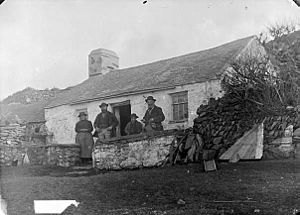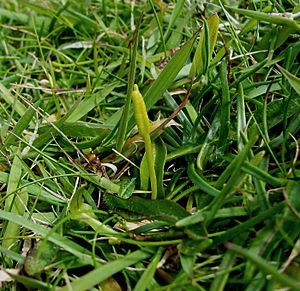Bardsey Island facts for kids
Bardsey Island (Welsh: Ynys Enlli) is a small island located about 1.9 miles (3.1 km) off the coast of Wales. It is 0.6 miles (1.0 km) wide and 1.0 mile (1.6 km) long, covering an area of 179 hectares (440 acres). The north-east side of the island rises steeply from the sea to a height of 548 ft (167 m) at Mynydd Enlli. The western part is flat farmland. To the south, the island narrows into a peninsula with a lighthouse. It is the fourth-largest island in Wales.
Bardsey Island has several interesting names. In Welsh, its name means "The Island in the Currents," because of the strong sea currents around it. In English, it might mean the "Island of the Bards" (ancient poets) or perhaps the "Island of Barda," who was a Viking chieftain. It is also famously known as the "Island of 20,000 saints."
The island has always been a very important religious place. In AD 516, Saint Cadfan built a monastery here. During the Middle Ages, many pilgrims traveled to the island. Even after Henry VIII closed the monastery in 1537, people still visit the island for its spiritual history.
Bardsey Island is also famous for its amazing wildlife and beautiful, wild scenery. A bird observatory was started in 1953 because the island is on important bird migration routes. It's a nesting place for birds like Manx shearwaters and choughs. You can also find rare plants and natural habitats that haven't been changed by modern farming. It's a great spot to see grey seals, dolphins, and porpoises.
The island's spiritual feeling, its quiet location, and the legend that King Arthur is buried there, have made it very special in Welsh culture. Many artists, writers, and musicians have been inspired by Bardsey Island, and it has led to award-winning books.
Contents
Island History
People have lived on Bardsey Island since Neolithic times, and you can still see traces of their old hut circles. In the 5th century, the island became a safe place for Christians, and a small Celtic monastery was built. In 516, Saint Cadfan came from Brittany and helped build St Mary's Abbey.
In medieval times, people believed that three pilgrimages to Bardsey Island were as important as one visit to Rome. By 1212, the abbey was part of the Augustinian Canons Regular. Many people still walk to Aberdaron and Uwchmynydd every year, following in the footsteps of the saints.
Today, only the ruins of the abbey's 13th-century bell tower remain. A Celtic cross in the ruins remembers the 20,000 saints said to be buried on the island. Saint Deiniol, a bishop, was buried here in 584.
In 1537, King Henry VIII ordered St Mary's Abbey to be closed, and its buildings were pulled down. Some parts, like the choir stalls and bells, were moved to Llanengan church.
For many years, Bardsey Island was part of the Newborough Estate. Between 1870 and 1875, the island's farms were rebuilt. A small limestone quarry was opened, and a lime kiln was set up. Most of the new houses were built as semi-detached homes. These buildings are now protected as Grade II listed buildings. Only one of the original small cottages, Carreg Bach, is still standing. In 1875, the islanders chose to build a Methodist chapel instead of a new harbor.
The island's population was 132 in 1881, but it dropped to 17 by 1961. The island's small school, which opened in 1919, closed in 1953. By 2003, only 4 people lived there.
The Bardsey Island Trust (Welsh: Ymddiriedolaeth Ynys Enlli) bought the island in 1979. They wanted to protect the wildlife, buildings, and archaeological sites. The trust also supports the island's art and culture and encourages people to visit its natural beauty. In 2000, the trust looked for someone to run the 440 acres (180 ha) sheep farm on the island and received 1,100 applications! The farm is now managed by the Royal Society for the Protection of Birds to protect the natural habitat. They grow oats, turnips, and swedes, and keep goats, ducks, geese, chickens, sheep, and Welsh black cattle.
Bardsey Apple
An old, twisted apple tree was found growing near Plas Bach, one of the island's buildings. People believe it's the last remaining tree from an orchard planted by the monks a thousand years ago. In 1998, apple experts confirmed that this tree was the only example of the Bardsey Apple (Welsh: Afal Enlli). New trees have been grown from it using grafting, and you can now buy them.
Bardsey Lighthouse
The Bardsey Lighthouse stands at the south end of the island. It helps guide ships through St George's Channel and the Irish Sea. It is the only square lighthouse looked after by Trinity House.
The lighthouse was built in 1821. It cost a lot of money back then! Joseph Nelson was the engineer and builder.
The lighthouse is made of ashlar limestone and is painted with red and white stripes on the outside. The tower is 30 m (98 ft) high. It's unusual because it's square, not round, like most lighthouses. It still has its original iron railings around the top. The light inside was updated in 1856 and again in 1873. It now gives off five flashes of light. It used to use an oil lamp but became electric in 1973.
The lighthouse is unusual because it doesn't have a harbor. Since it's on a bird migration route, many birds crash into the tower. The Royal Society for the Protection of Birds and Trinity House have tried to help by adding perches and flood-lighting the tower, but it hasn't solved the problem.
In 1987, the lighthouse became automatic, meaning it runs by itself. A local person now does regular checks and maintenance.
Wildlife on Bardsey Island

Bardsey Island was made a National Nature Reserve in 1986. It is also part of the Glannau Aberdaron ac Ynys Enlli Special Protection Area. It's a very popular place for bird-watching because thousands of birds pass through on their migration routes. The Bardsey Bird and Field Observatory, started in 1953, catches and rings about 8,000 birds each year to study where they travel.
The island is also a Site of Special Scientific Interest because of its amazing sea life. This includes rare lichens, plants, and bird species. Some important flowering plants found here are sharp rush, rock sea lavender, small adder's tongue, and rare purple loosestrife. There are over 350 types of lichen on the island. The leafcutter bee, which uses neat, rounded pieces of rose leaves to seal its nest, also lives here.
Thousands of birds visit the island each year on their way to their breeding or winter homes. Birds like Chiffchaffs, goldcrests, and wheatears are usually the first to arrive, followed by sedge warblers, willow warblers, whitethroats, and spotted flycatchers.

About 30 different species of birds regularly nest on the island. These include ravens, little owls, oystercatchers, and the rare chough. Hundreds of sea birds, such as razorbills, guillemots, fulmars, and kittiwakes, spend the summer nesting on the island's eastern cliffs. There are no land predators like rats or foxes on the island. On dark nights, you can hear a strange cackling sound from the 7,000 pairs of Manx shearwaters that come ashore to lay their eggs in old rabbit burrows.

Bardsey Island is one of the best places in Gwynedd to see grey seals. In mid-summer, you can spot over 200 seals relaxing on the rocks or swimming. About 15 seal pups are born here every autumn. Their strong jaws help them break the shells of lobsters and crabs that live in the surrounding waters. You might also see bottlenose and Risso's dolphins, and porpoises. The currents around the island bring in lots of food for marine life. The Whale and Dolphin Conservation Society has been studying these waters since 1999 to find important feeding and nursing areas for calves.
The seas around the island are full of marine life. There are underwater forests of strap seaweed. In the rock pools, you can find sea anemones, crabs, and small fish. In deeper waters, the rocks are covered by sponges and sea squirts. A special yellow star anemone, usually found in the Mediterranean, also lives here.
Island Culture
It was a tradition for the islanders to elect a "King of Bardsey" (Welsh: Brenin Enlli). From 1826, the Baron Newborough or his representative would crown him. The crown is now kept in a museum in Liverpool. The last king, Love Pritchard, offered himself and the island's men for military service at the start of World War I. He was refused because he was 71 years old, which made him angry, so he declared the island a neutral power!
Many artists and writers have been inspired by Bardsey Island. Poet Christine Evans lives half the year on the island. She started writing poems in 1976, and her work has won awards.
Edgar Ewart Pritchard made a color movie about life on Bardsey Island in 1953, called "The Island in the Current". A copy is kept at the National Screen and Sound Archive of Wales.
Opera singer Bryn Terfel, who supports the Bardsey Island Trust, has performed in the island's chapel. Musician Llio Rhydderch recorded an album called Enlli in 2002, inspired by the island's spiritual feeling.
Dilys Cadwaladr, a former teacher on the island, was the first woman to win the Crown at the National Eisteddfod in 1953 for her long poem. Artist Brenda Chamberlain won the Gold Medal for Art twice for her paintings. Some of the murals she painted can still be seen on the walls of Carreg, where she lived. Wildlife artist Kim Atkinson also lived on the island as a child and returned in the 1980s.
Since 1999, the Bardsey Island Trust has had an Artist in Residence who spends several weeks on the island creating art. A Welsh writing residency was started in 2002. Singer-songwriter Fflur Dafydd spent six weeks there, which inspired her play Hugo and two novels.
In 2009, Cowbois Rhos Botwnnog became the first electric rock band to play on the island as part of a TV series.
Getting to Bardsey Island
There are ferry services to Bardsey Island from Porth Meudwy and Pwllheli.
Sometimes, strong winds and fierce sea currents make it impossible to sail between the island and the mainland. This means boats can't reach or leave Bardsey Island for weeks. For example, in 2000, 17 visitors had to stay on the island for two extra weeks because of strong winds.
Images for kids
-
16,000 pairs of Manx shearwaters come ashore each year, under cover of darkness, to nest on Bardsey Island.
See also
 In Spanish: Isla Bardsey para niños
In Spanish: Isla Bardsey para niños












